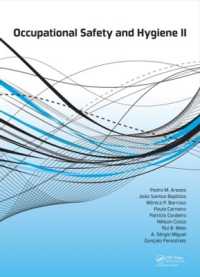- ホーム
- > 洋書
- > ドイツ書
- > Mathematics, Sciences & Technology
- > Technology
- > construction & environment engineering
Full Description
ETFE foil has recently become an important material for the cladding of technologically sophisticated and innovative buildings. This material is very thin and lightweight and, when used in air-filled cushion assemblies, has enormous strength and a range of adaptive environmental attributes. ETFE cushion enclosures became known primarily through Grimshaw Architects' Eden Project and Herzog + de Meuron's Allianz Arena, and they are being used on the spectacular swimming stadium for the 2008 Olympic Games in Beijing, the largest ETFE building envelope in the world so far.
This book is conceived as an in-depth introduction to the characteristics of ETFE and its applications in construction. Project examples explore in detail the specific characteristics of ETFE building skins in the areas of structural behavior, light transmission, insulation, acoustics, fire engineering and environmental modification.
Contents
Foreword Ian Liddell
1. Introduction: Pleasure, Power and Payload
evolution of balloons / the pneumatic imagination
evolution of concepts of ideal environment - Garden of Eden to Crystal Palace
2. The Pneumatic Imagination: Architectural Ideas and Applications
Concepts of lightness, efficiency (doing more with less) and total environments as developed by Buckminster Fuller, Walter Bird, Frei Otto and Archigram
3. Material Matters: ETFE
Material ingredients/chemical makeup, manufacture/processing, properties
Who developed ETFE, original use and subsequent applications outside architecture and building construction
manufacturing of ETFE films (cutting and patterning, welding, printing)
first generation ETFE architectural projects
-Munich Olympics maintenance depot (Gunter Behnisch)
-Botanical and aquatic enclosures in Germany and the Netherlands- Vector/Foiltec
Design and Production Stefan Lehnart
4. Soft Structure
characteristics of the material: yield, equilibrium with air pressure
characteristics of the cushion system; fluid damping, synclastic system, size and shape, span, air pressure, camber, lighter primary structure, elimination of secondary structure, temperature and humidity, creep, edge stresses / edge details, puncture / repair
5. The Performative Skin
Light transmission / UV transmission
Degradation
Thermal performance
Acoustics
Fire
Sustainability - raw materials, embodied energy, energy consumption in use, recycling,
Cradle-to-cradle
Energy production / photovoltaics
6. Environmongery - The Variable Skin
Ability to change light transmission, thermal attributes and appearance through variable air pressure
7. Life Safety
8. The Communicative Skin
9. The Climatic Envelope: The Next Generation
-Projects now on the drawing boards offer the potential of achieving the large environmental envelopes envisioned by Fuller, Otto and others.
-Implications/projections/crystal gazing
Public vs private realms
Liberation vs captivation (internal freedom vs external control)
Flexibility vs monoculture
Sustainability and the environment
Afterword Ben Morris
Project credits
Bibliography
Acknowledgments / image credits







